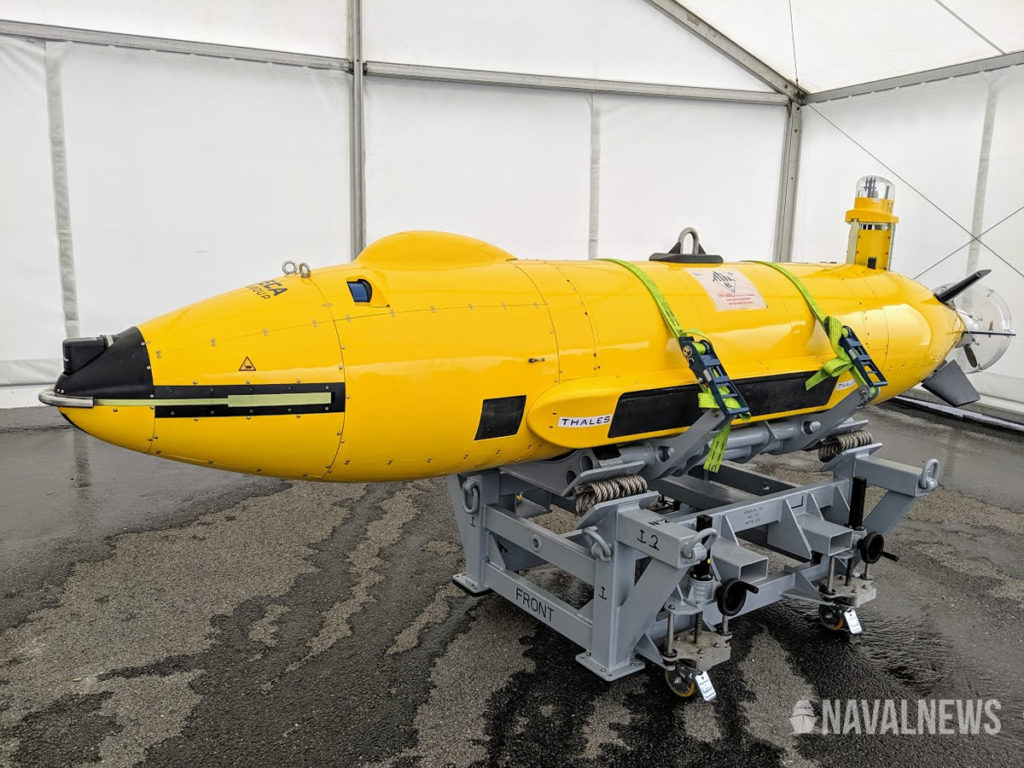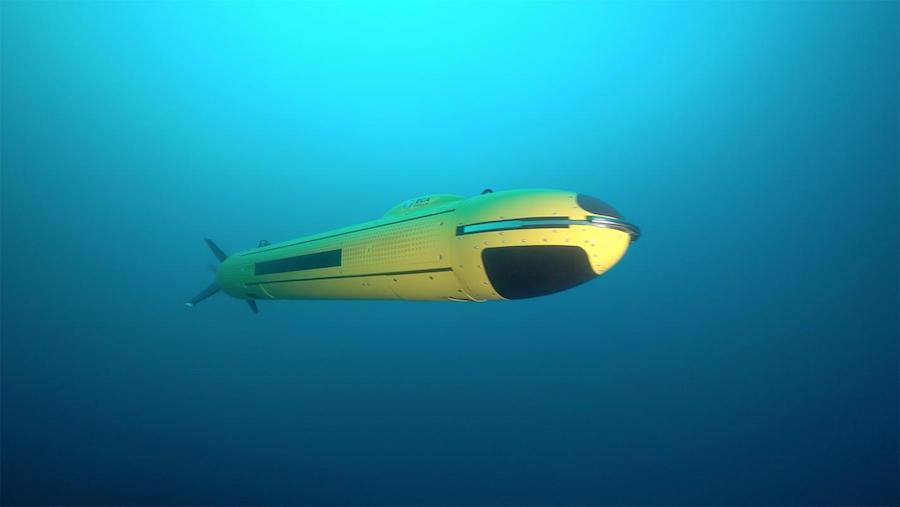The SLAM-F / MMCM mine warfare system will allow French and British sailors to operate remotely and stay out of the mine field through the use of unmanned systems. However, many questions remain regarding the exact type of UUVs and USVs France and the Royal Navy plan to procure.
SLAMF will eventually replace all current mine warfare means (Tripartite-class mine hunters, sonar towing vessels, EOD diver vessels) of the French Navy. What will replace the existing Royal Navy MCM vessels (Hunt-class and Sandown-class) is still an unknown.
SLAMF will contribute in particular to ensuring the freedom of maneuver of the nuclear deterrent force by securing the implementation of the nuclear strategic units of the French Navy (SSBNs, aircraft carriers). It will be used to protect access to French ports and, depending on the circumstances, to support the deployment of a naval force, to participate in crisis prevention or to intervene in contested environment.

The SLAMF program consists of four components:
- 8x Unmanned systems (details below) including 4 to be delivered by 2024
- 6x motherships for UAV/USV/UUV known as “bâtiments de guerre des mines” (BGDM)
- 5x EOD divers support vessels known as “bâtiments base plongeurs démineurs nouvelle generation” (BBPD NG)
- 1x Mine Warfare Data Operating System (SEDGM).Mine Warfare Data Operating System (SEDGM).
Each of the four “unmanned systems” mentioned above represents a mine warfare module consisting of:
- 1x Remotely Operated Vehicle (ROV), to identify and neutralize sea mines.
- 3x Autonomous Underwater Vehicles (AUV),
- 2x Unmanned Surface Vessel (USV),to detect, classify and locate (DCL functions) the mines.
The motherships will displace between 3,000 and 4,000 tons with a length close to 90 meters. It will take sailors “out of the mine field” in a similar fashion to the MCM replacement program of the Belgian and Dutch navies. Both programs are replacing the Tripartite-class MCM vessels. We were told in the past that the BGDM could feature a well deck to ease the launch and recovery of USVs and UUVs but it seems like this configuration has not be retained.
The initial mine warfare modules will be land based and deployed directly from the naval bases, especially in Brest which is close to the French Navy’s SSBN fleet. Initial operational capacity (IOC) of the first system is set for 2023.
Questions on the unmanned systems
As mentioned, many question marks remain regarding the exact type of UUVs and USVs France and the Royal Navy plan to procure. The systems procured so far for the program were limited to the demonstration phase:
The ROV used in this demo phase was the Multi-Shot Mine Neutralization System by Saab. The UUV/AUV was the A27 Espadon (Swordfish) by ECA Group with Thales payloads. The USV was the C-Sweep by L3Harris ASV equipped with a towed sonar (the TSAM by Thales). To learn more about each of these systems, check out our video report recorded last year.
The Royal Navy evaluated another USV in addition to the C-Sweep: the ARCIMS by Atlas Elektronik UK.
Which UUV/AUV for SLAMF / MMCM ?

The A27 Espadon was used for the demonstration phase of SLAMF/MMCM. The exact type of AUV still needs to be formally confirmed as it was just turned down by the Royal Navy. Details of this initially surfaced in an “information report” on the ten years of the Lancaster House agreements by two French MPs:
A set comprising a surface drone and a Thales sonar should soon go into production, which of course satisfies the manufacturer and the DGA. As for the underwater drone designed to detect mines at greater depth, the ECA Group proposal has not been convincing. The DGA has suggested that the British continue to work on this second drone, with no positive response so far.
Naval News contacted both the DGA and ECA Group to shed light on the above statement. However we not yet heard from either party.
Combining information from both French and British sources, Naval News understands the issue with the A27 that was tested during the demonstration phase has to do with:
- cost, weight and power issues linked to its payload: The SAMDIS synthetic aperture sonar by Thales,
- footprint and weight: The Royal Navy found the A27 AUV as being too large and heavy (at 1 ton) since the early stages of the program,
- the fact that the A27, designed in 2010, is one generation older compared to the newest mid-size UUVs available today.

The Royal Navy is now seeking a new UUV system. This has not been confirmed by official sources but we, at Naval News, believe that ECA Group will likely propose its newer AUV: The A18M with its own sonar payload. But other major players of the UUV industry are set to compete as well such as Bluefin Robotics, Hydroid, Teledyne Gavia, L3Harris and of course Riptide which was acquired by BAE Systems last year… In the context of the 10 years of the Lancaster House agreements and for the sake of the “entente cordiale”, it would seem logical if DE&S and the Royal Navy selected the French A18M.
It is not decided yet whether the DGA will stick to the original plans and procure the A27 for the French Navy AUV needs or seek an alternative as well. The natural choice being the A18M as it has already been selected by Belgium and the Netherlands for the rMCM program. This AUV is actually becoming a NATO mine warfare standard as it was recently selected by Latvia as well.
Which USV and ROV for SLAMF / MMCM ?

In its press release issued 3 November, the DGA mentions the following:
The design study and the production of the prototypes of the drone system have been entrusted to Thales, of which ECA will be the main French subcontractor. The industrial organization of SLAM-F will be gradually defined during the award of the contracts relating to the various components of the program.
DGA
The above statement means that nothing is decided yet, not just regarding the UUV, but for other key elements of the mine warfare system such as the USV and the ROV. Consultations relating to the markets quoted above will probably take place in 2021. They will enable the French unmanned systems specialist ECA Group to find out which ones of the 4 + 4 drone systems it will be contracted to deliver for the French SLAMF program.
Once again, ECA Group has the full range of unmanned systems readily available and already selected by NATO navies (Inspector USV, T18M towed sonar, and KSTER for mine neutralization). For France however, the Thales USV and towed sonar previously used in the demonstration phase are likely to stay because of the investment already conceded in those two systems.
On the British side, as mentioned, the choice on the USV platform will likely be between the C-Sweep by L3Harris ASV / Thales and the Arcims by AEUK as both systems were evaluated during the demonstration phase. C-Sweep is proprietary to the Thales USV system and embodies specific autonomy algorithms developed by Thales. Arcims is already procured for Project Wilton and Sweep demonstrator.
Which MCM motherships for the Royal Navy ?

On the British side, plans for the motherships are still not clear. Several sources mentioned to Naval News plans of early retirement the existing fleet of Hunt-class and Sandown-class MCM vessels. Rumor has it the unmanned systems would (initially at least) be deployed from vessels of opportunity (OSV types) or even the future Type 26 and Type 31 frigates.
About SLAMF / MMCM Program
In 2012, UK and France initiated the Maritime Mine Counter Measures (MMCM) programme which aims at developing a prototype autonomous system for detection and neutralisation of sea mines and underwater improvised explosive devices (UWIEDs). Managed by the OCCAR European agency, the MMCM contract was awarded to Thales, in collaboration with BAE Systems and their partners in France (ECA) and in the UK (ASV, Wood & Douglas, SAAB).
MMCM is a complete mine warfare system, composed of Unmanned Surface Vehicle (USV) and Underwater Unmanned Vehicles (UUVs), aiming at replacing French Marine Nationale and UK Royal Navy current fleets of mine hunters. As part of the MMCM programme, Thales and BAE Systems are committed to providing systems to both the French Navy and Royal Navy for two years of evaluation testing, under the SLAMF and MHC programs respectively.






